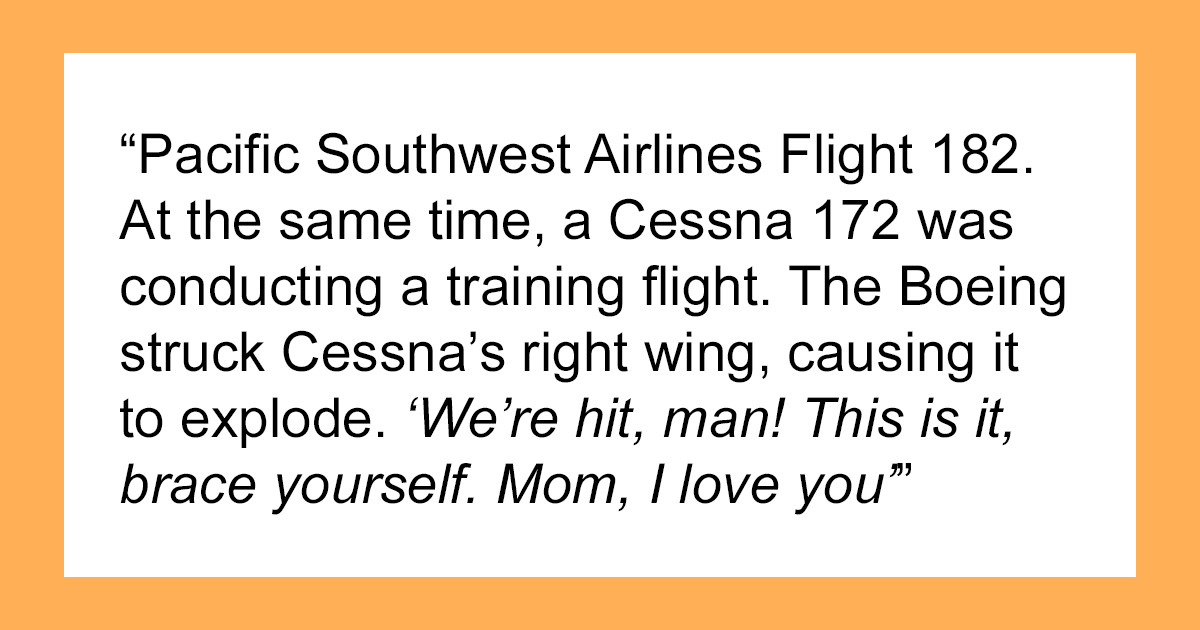14 Heart-Stopping Pilot Confessions Moments Before Disaster Strikes in the Sky
 August 31st, 1988, Texas. At Dallas-Fort Worth International Airport, 104 passengers were boarding a Boeing 727 operated by Delta Airlines, Bound for Colorado Springs. The cockpit voice recorder captured a conversation between the pilots and a flight attendant as the crew awaited takeoff clearance. They shared thoughts on the presidential election, and joked that in the event of an accident, they should leave something funny on the voice recording. This was a blatant violation of the sterile cockpit rule, which prohibits informal conversations during critical phases of flight.
August 31st, 1988, Texas. At Dallas-Fort Worth International Airport, 104 passengers were boarding a Boeing 727 operated by Delta Airlines, Bound for Colorado Springs. The cockpit voice recorder captured a conversation between the pilots and a flight attendant as the crew awaited takeoff clearance. They shared thoughts on the presidential election, and joked that in the event of an accident, they should leave something funny on the voice recording. This was a blatant violation of the sterile cockpit rule, which prohibits informal conversations during critical phases of flight.
However, the first pilot, Wilson Kirkland, continued chatting during the engine’s start-up checklist, and Captain Larry Davis didn’t attempt to stop him. As the plane approached the runway, Wilson called out each item on the checklist, and Kirkland confirmed readiness, “Engine anti-ice?” “It’s closed.” “Shoulder harness?” “They’re on.” “Flaps?” “15,15, green light.” This indicated the flap setting, which, in reality, had not deployed.
The captain increased the engines to take off power. The nose lifted, but the plane struggled to get airborne. Strangely, the system did not warn of the retracted flaps. Finally, the Boeing barely climbed to around 150m. when the takeoff configuration warning system activated, indicating major issues, but the crew couldn’t understand why. “Something’s wrong!” The plane shook violently, and the pilots hesitated. “We got an engine failure!” Kirkland exclaimed. In reality, had the pilots lowered the nose, it would have allowed the airflow to pass correctly through the engines, and they would have resumed functioning. Since they didn’t, the plane descended and sped toward the end of the runway.
The captain tried to regain control, but it was too late, “We’re not going to make it!” In less than a second, the right wing clipped an instrument landing system antenna, and the plane crashed to the ground. The Boeing broke into 3 pieces and came to a stop near the airport fence.
Flames erupted from the fuel tanks, sending a column of black smoke over the airport. Surviving passengers and crew frantically scrambled from the wreckage, helping those pinned beneath heavy debris. The tragedy claimed 27 lives, including both Pilots, while over 80 others were injured.
Meanwhile, Baggett Law notes that the chances of a commercial airplane crashing are a tiny 0.000001%. The odds of you losing your life in a plane crash are 1 in 816,545,929. “To put it into perspective, you have a better chance of winning a Powerball jackpot.”
 Flight 2605 of Western Airlines was nicknamed the Night Owl. It crashed on Halloween 1979. Due to fog, the pilots landed on a closed runway with trucks and workers. The plane hit a truck and crashed into a building. The last words of the pilots, recorded by the cockpit voice recorder:
Flight 2605 of Western Airlines was nicknamed the Night Owl. It crashed on Halloween 1979. Due to fog, the pilots landed on a closed runway with trucks and workers. The plane hit a truck and crashed into a building. The last words of the pilots, recorded by the cockpit voice recorder:
Captain: We’re cleared on the right, is that correct?
Captain: No, this is the approach to the god-d**n left.
First officer: Yeah, climb to 8500 and uh-
First officer: Charlie, get it up!
Captain: Oh Jesus Christ!
[screaming in terror and sound of final impact]
 On a stormy Day in 1985, Delta flight 191 was flying from Florida to Los Angeles with a stop in Dallas. As it neared the runway, a sudden gust of wind slammed it to the ground. It hit a car and two water tanks and exploded. 137 lives were lost in a microburst. The last words of the pilots were recorded by the cockpit voice recorder:
On a stormy Day in 1985, Delta flight 191 was flying from Florida to Los Angeles with a stop in Dallas. As it neared the runway, a sudden gust of wind slammed it to the ground. It hit a car and two water tanks and exploded. 137 lives were lost in a microburst. The last words of the pilots were recorded by the cockpit voice recorder:
Captain: You’re gonna lose it all of a sudden. There it is. Push it up, push it way up, way up.
Flight engineer: Push it way up!
First officer: S**t!
[sound of impact]
 Royal Air Maroc Flight 630. The flight took off from Agadir, Morocco, in 1994, but it never reached its destination. One of the pilots crashed the plane on purpose, killing all 44 people on board. Here are the last words of the pilot:
Royal Air Maroc Flight 630. The flight took off from Agadir, Morocco, in 1994, but it never reached its destination. One of the pilots crashed the plane on purpose, killing all 44 people on board. Here are the last words of the pilot:
Pilot: Don’t come fast… Come slowly, bring it slowly. Don’t lose the axis. It’s unbalanced. Get me this fuel!
Tower: Turn left after takeoff!
Pilot: I’m going to die!
Co-pilot: No! No, no, not old man!
Pilot: What did you do?!














